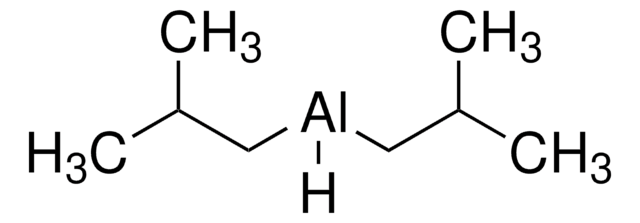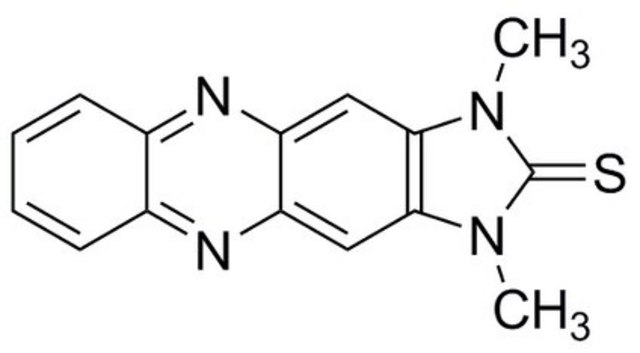256870
Diisobutylaluminum hydride solution
1.0 M in toluene
Sign Into View Organizational & Contract Pricing
All Photos(1)
Synonym(s):
DIBAL, DIBAL-H
Linear Formula:
[(CH3)2CHCH2]2AlH
CAS Number:
Molecular Weight:
142.22
Beilstein:
4123663
MDL number:
UNSPSC Code:
12352001
PubChem Substance ID:
Recommended Products
reaction suitability
reagent type: reductant
concentration
1.0 M in toluene
density
0.858 g/mL at 25 °C
SMILES string
CC(C)C[AlH]CC(C)C
InChI
1S/2C4H9.Al.H/c2*1-4(2)3;;/h2*4H,1H2,2-3H3;;
InChI key
AZWXAPCAJCYGIA-UHFFFAOYSA-N
Looking for similar products? Visit Product Comparison Guide
Application
Used in Pd-catalyzed reductive debromination of secondary alkyl bromides. O-Debenzylation and ring opening of perbenzylated furanosides. Convenient in situ generation of HZrCp2Cl from ZrCp2Cl2 and DIBAL-H.
Recommended products
Angled septum-inlet adapter Z118206 or straight septum-inlet adapter, 6mm I.D. inlet, Z118141 or straight septum-inlet adapter, 13mm I.D. inlet, Z118192 is recommended.
septum inlet adapter
Product No.
Description
Pricing
Regulatory Information
新产品
Certificates of Analysis (COA)
Search for Certificates of Analysis (COA) by entering the products Lot/Batch Number. Lot and Batch Numbers can be found on a product’s label following the words ‘Lot’ or ‘Batch’.
Already Own This Product?
Find documentation for the products that you have recently purchased in the Document Library.
Hidetsura Cho et al.
The Journal of organic chemistry, 75(3), 627-636 (2009-12-31)
A systematic investigation of the reductive ring-expansion reaction of cyclic ketoximes fused to aromatic rings with diisobutylaluminum hydride (DIBALH) is described. This reaction regioselectively afforded a variety of five- to eight-membered bicyclic heterocycles or tricyclic heterocycles containing nitrogen neighboring an
D J Kopecky et al.
The Journal of organic chemistry, 65(1), 191-198 (2000-05-18)
An optimized protocol for the DIBALH reductive acetylation of acyclic esters and diesters is described. This reductive acetylation procedure allows a wide variety of esters to be converted into the corresponding alpha-acetoxy ethers in good to excellent yields. It was
Y Kitade et al.
Nucleic acids symposium series, (27)(27), 107-108 (1992-01-01)
Reaction of purine nucleosides, such as 2',3'-isopropylideneinosine (1a) and 2',3'-isopropylideneadenosine (1c), with diisobutylaluminum hydride (DIBAL) in dry tetrahydrofurane resulted in the formation of the corresponding 9-(2',3'-isopropylideneribity)purines (2) in good yields. Oxidation of the ribityl derivatives (2) with NalO4 and subsequent
J Marco-Contelles et al.
Carbohydrate research, 335(1), 63-70 (2001-09-13)
The reaction of DIBALH with bis(heteroannulated)-pyranosides containing the perhydrofuro[2,3-b]pyran moiety is described. The hydride attack at the anomeric carbon (C-9a) resulted in the exclusive tetrahydrofuran ring opening. The selectivity of this reaction has been evaluated as other benzylidene acetals built
Takashi Tomioka et al.
The Journal of organic chemistry, 76(11), 4669-4674 (2011-04-30)
Stepwise, selective DIBAL reduction of the acetonide diester derived from tartaric acid followed by the Horner-Emmons reaction effectively provided desymmetrized hydroxy mono-olefination products in a one-pot operation.
Our team of scientists has experience in all areas of research including Life Science, Material Science, Chemical Synthesis, Chromatography, Analytical and many others.
Contact Technical Service

![(+)-1,2-Bis[(2R,5R)-2,5-diethylphospholano]ethane kanata purity](/deepweb/assets/sigmaaldrich/product/structures/117/111/c55f56e4-37a9-419e-9eee-e4b57110aec6/640/c55f56e4-37a9-419e-9eee-e4b57110aec6.png)